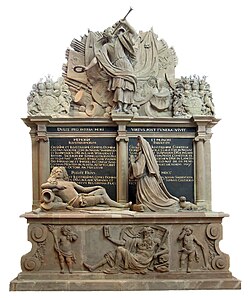Gustav Adolph, Count of Nassau-Saarbrücken
He was the third son of Count William Louis of Nassau-Saarbrücken (1590 – 22 August 1640) and Countess Anna Amalia of Baden-Durlach (1595–1651), who named him after king Gustav II Adolf of Sweden, who was still alive at the time.In 1658 he fought against Denmark in the service of the Swedish king Charles X Gustav, who was a duke of the house Palatinate-Zweibrücken.He set about rebuilding the war-ravaged country, brought back refugees and recruited settlers for agriculture and skilled workers for the glass industry in Klarenthal.He refused to swear the required oath of fealty from the king, even when he was captured in 1673 by the French and taken to Metz.His body was transferred and buried in the tomb erected by his wife in the castle church in Saarbrücken in 1998.
SaarbrückenStrasbourgNoble familyHouse of NassauWilliam Louis, Count of Nassau-SaarbrückenAnna Amalia of Baden-DurlachMajor GeneralHoly Roman Empire of German NationWilliam Louis of Nassau-SaarbrückenGustav II Adolf of SwedenThirty Years' WarCharles X GustavPalatinate-ZweibrückenJohn LouisWalradSaarwerdenLouis XIVreunion policyAlsaceLouis CratoCharles LouisAlbert Wolfgang, Count of Hohenlohe-LangenburgAllgemeine Deutsche BiographieNeue Deutsche BiographieWilliam LouisNassau-Saarbrücken